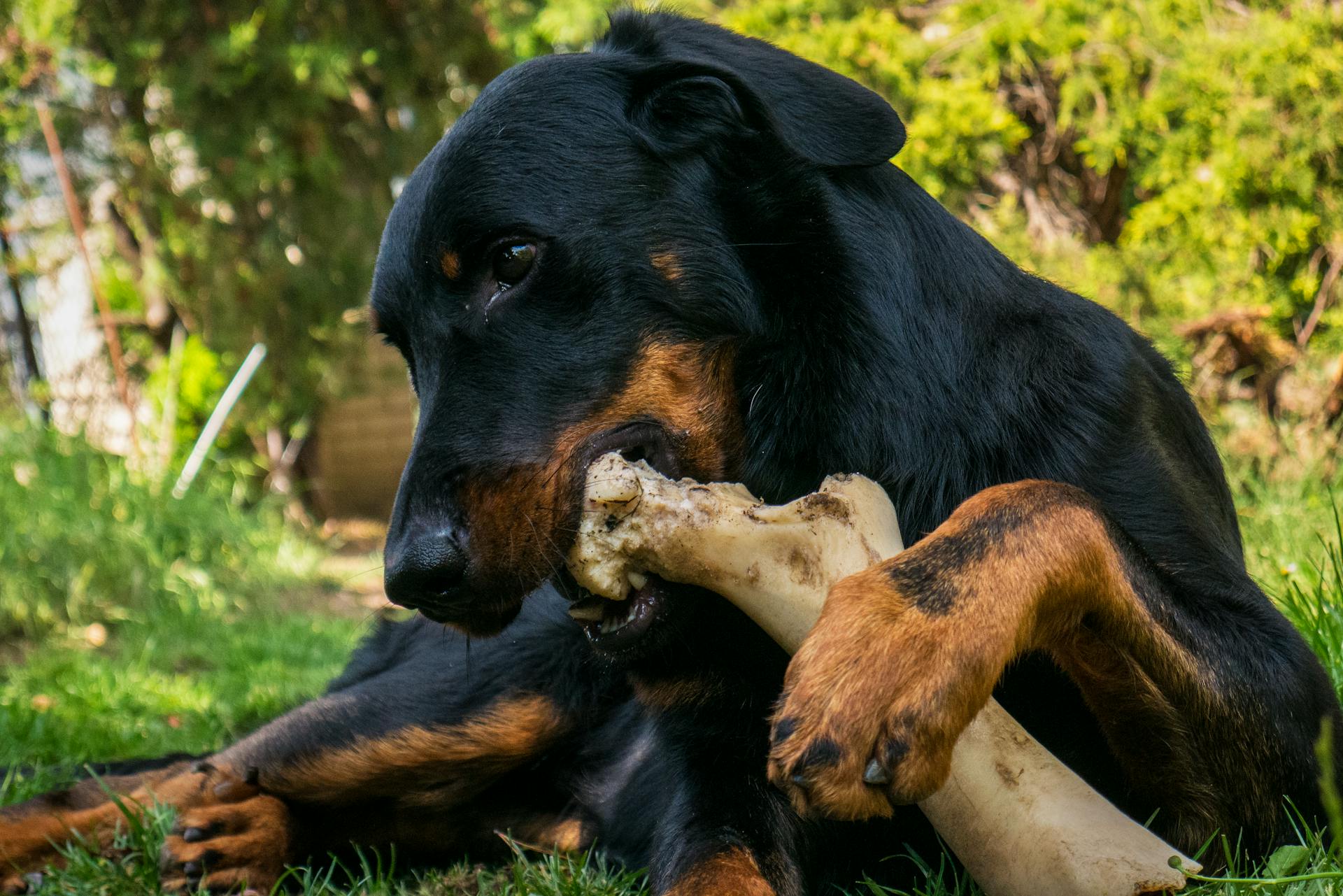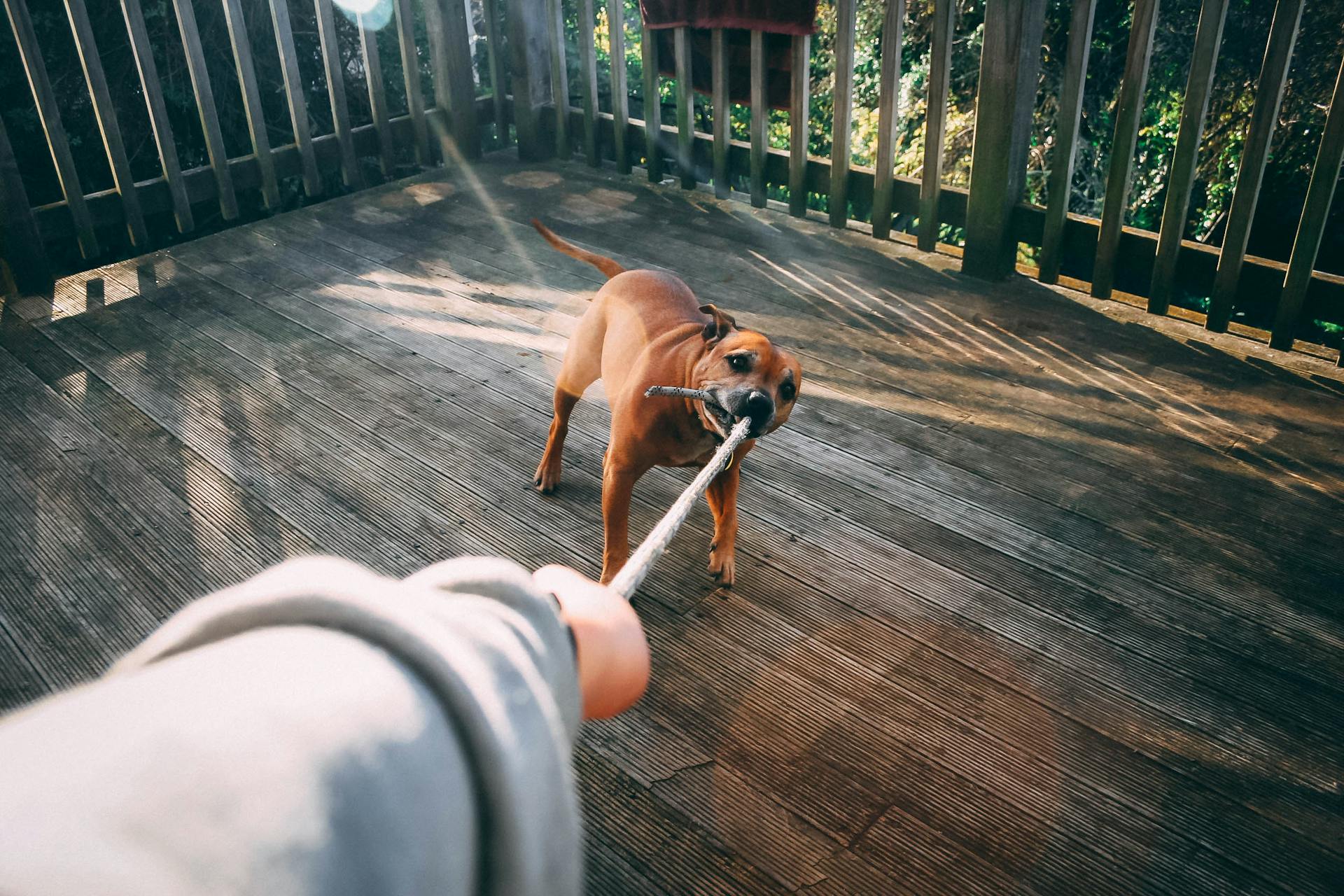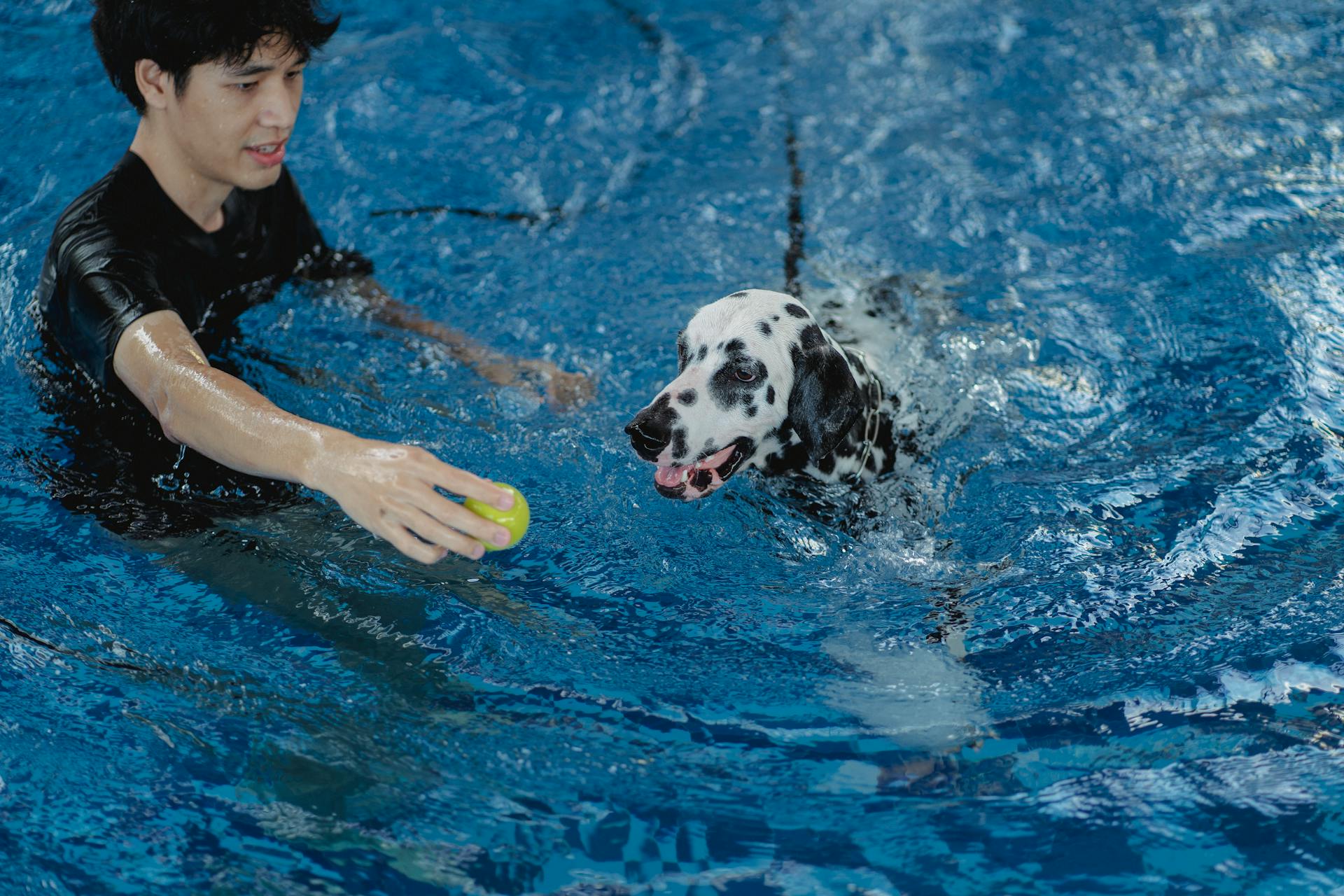
Dog bites can happen to anyone, but there are steps you can take to prevent them. According to the American Veterinary Medical Association, 4.5 million people in the United States are bitten by dogs each year.
Knowing the warning signs of an aggressive dog is crucial. A study found that 71% of dog bites occur on the owner's property, often because the dog was feeling territorial or protective.
Children are often the victims of dog bites, with the majority of bites occurring to those under the age of 12. This is why it's essential to teach children how to interact with dogs safely.
If you're planning to get a dog, consider the breed and its temperament. Some breeds are naturally more aggressive than others, and research has shown that certain breeds are more likely to bite.
See what others are reading: Top Biting Breeds of Dogs
Preventing Dog Bites
Preventing dog bites requires a combination of responsible pet ownership, education, and awareness. Socialization is a crucial step in preventing dog bites, especially during a dog's puppy stage.
Introducing your dog to other animals and people while it's still a puppy will help your pet feel more comfortable in different situations. This will make it easier to interact with others as it gets older.
Carefully selecting the right dog for your family is essential. Research the breed and its temperament before adopting a new pet. Proper training, regular exercise, and neutering or spaying your pet are also responsible habits for pet owners.
Dogs rely on body language, posture, and vocalizations to express themselves. Reading a dog's body language can give us helpful clues as to whether a dog is feeling stressed, frightened, or threatened.
Here are some key signs to look out for:
- Sleeping or resting in a high-traffic area
- Growling or barking when approached
- Displaying a stiffened posture or raised hackles
- Direct eye contact or staring
- Exposing teeth or showing aggression
Being a responsible pet owner involves obeying leash laws, securing your dog in a separate room or area, and regularly monitoring your dog's behavior. If you notice any signs of aggression, consult a veterinarian to determine the cause and seek treatment.
Keep your dog healthy by vaccinating it against rabies and preventable infectious diseases. Regular exercise and mental stimulation can also help prevent biting behavior.
Understanding Dog Behavior
Dogs use body language to express themselves, but it's not always easy to read. One dog wagging its tail might mean it's happy to see you, while the same gesture in another dog might mean it's anxious or nervous.
Dogs have unique personalities, and their body language can vary greatly. Sometimes, they'll yawn, put their ears back, or raise a paw if they're feeling worried. If a dog tucks its tail under its belly or leg, lies down with a leg up, or stiffens its body and stares at you, it could be trying to tell you that it's frightened or threatened.
To determine if a dog wants to be with you, look for signs of relaxation and friendliness. If the dog is calm and happy to see you, it's likely in a good, playful mood. However, if the dog won't look at you or is avoiding you, it's probably best to leave it alone.
A fresh viewpoint: Female Dog Biting Tail
Key Signs to Watch for:
- Relaxed and friendly demeanor
- Willingness to make eye contact
- Calm body language
- Avoiding you or hiding can be a sign of stress or fear
Remember, always ask the owner for permission before petting a dog you don't know, and never leave young children alone with a dog without adult supervision.
Reading Body Language
Reading dog body language is crucial to understanding their behavior and preventing potential conflicts. Dogs can't talk, so they rely on body gestures and postures to express themselves.
Dogs, like people, have unique personalities and express themselves differently. What one dog considers a friendly gesture, another dog might interpret as anxiety or nervousness.
A dog may yawn, put its ears back, or raise a paw if it's feeling worried. As the situation escalates, its behavior will change. For example, if a dog tucks its tail under its belly or leg, lies down with a leg up, or stiffens its body and stares at you, it's trying to tell you it's frightened or threatened.
Some signs that a dog wants to be left alone include growling, snapping, or biting. Remember, a dog's size and breed don't predict whether it will bite or not.
Explore further: Will Cockroach Poison Kill My Dog
So, next time you're around a dog and want to play, ask yourself: Does the dog seem like it wants to be with you? If the dog is relaxed and friendly, and seems happy to see you, it's probably in a good, playful mood.
Here are some signs to look out for:
- If the dog won't look at you or is avoiding you, it's probably best to let it go on its way.
- If it seems tense and nervous, or seems to be staring at you, stay away.
- If it's not your dog, always rely on its owner to help you understand the pet's mood.
Always ask the owner's permission before petting a dog you don't know.
Socialization of Cats
Socialization of cats is crucial to help them feel comfortable in various situations. It prepares them to enjoy interactions with other animals and people.
Early socialization, ideally from an early age, helps cats become confident and calm in the presence of new people and animals. This can make a big difference in their behavior as they grow older.
Socialization also helps cats get used to different environments and activities, which is essential for their well-being.
See what others are reading: Do Fisher Cats Attack Dogs
Breed-Specific Legislation Is Not the Answer
Breed-specific legislation may look good on the surface, but it's not a reliable or effective solution for dog bite prevention. This approach targets specific breeds, such as Pit Bulls, but it doesn't address the root causes of dog bites.
Many dog bites are caused by irresponsible ownership, not the breed itself. Irresponsible owners can be from any background, and their behavior is what matters, not the breed of their dog.
Studies have shown that breed-specific legislation doesn't reduce dog bites. In fact, it can even lead to more problems, such as driving responsible owners underground and making it harder to enforce existing laws.
By targeting specific breeds, breed-specific legislation ignores the complexities of dog behavior and the many factors that contribute to dog bites. It's a simplistic solution to a complex problem.
Take a look at this: Training Your Dog Not to Bite
Ask About History
If the dog's owner is nearby, ask for the dog's vaccination history, making sure to get the owner's name, telephone number, and veterinarian's contact information.
It's also a good idea to ask to see some sort of ID to verify the owner's identity.
In case the dog is unaccompanied, ask anyone who witnessed the attack if they're familiar with the dog and know where the owner lives.
Even if the dog is familiar, it's still possible to be bitten, so keeping up with your dog's rabies inoculations is crucial, even for friendly animals.
A fresh viewpoint: Pitbull Dog Bite Owner
Responding to a Bite
If you're bitten by a dog, it's essential to take immediate action to prevent infection and potential rabies. Clean the wound with mild soap and running water, then cover it with a clean bandage or cloth.
Some wounds may require stitches, ideally within 12 to 24 hours. If you're bitten by an unknown or stray dog, go to the emergency room to receive post-exposure prophylaxis against rabies, if necessary.
If the injury is minor and from a family dog with a current rabies vaccine, clean the wound and monitor it for signs of infection. Your regular healthcare provider may recommend simply keeping an eye on the wound, but always err on the side of caution and seek medical attention if you notice any redness, pus, pain, swelling, or warmth.
Here's a quick rundown of what to do in case of a dog bite:
- Clean the wound with mild soap and running water
- Cover the wound with a clean bandage or cloth
- Monitor the wound for signs of infection
- Seek medical attention if you notice any redness, pus, pain, swelling, or warmth
Bite Response
If the dog's owner is present, request proof of rabies vaccination, and get the owner's name and contact information. This is crucial in case the dog's vaccination records need to be checked.
A fresh viewpoint: What Is the Purpose of Biting a Dog's Ear?
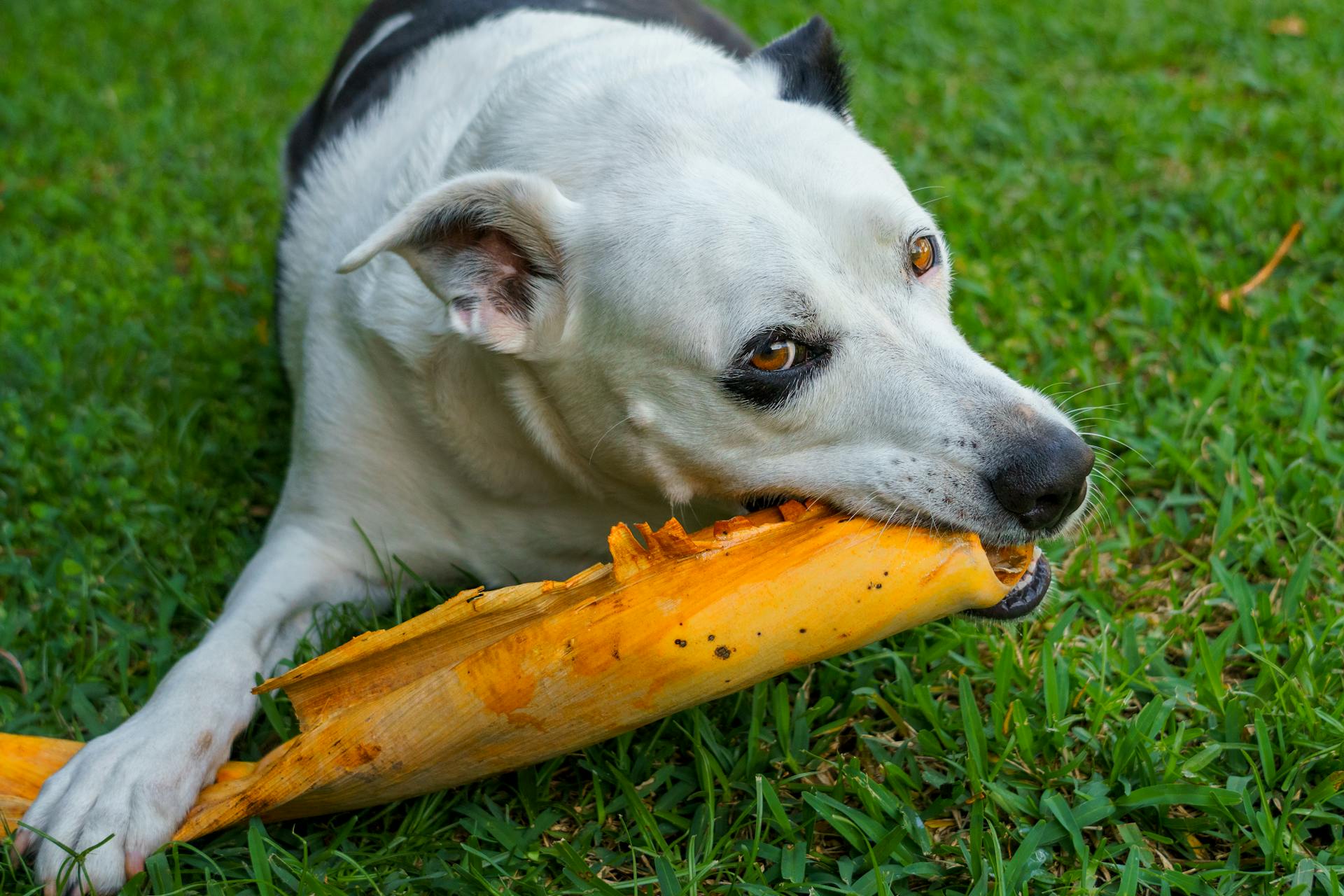
Cleaning the bite wound with soap and water as soon as possible is essential. This helps prevent infection and reduces the risk of rabies.
If it's after office hours, consult your doctor immediately or go to the emergency room. Don't wait until morning, as prompt medical attention is vital.
Restrain your dog immediately to prevent further harm. This is a critical step in preventing more bites.
Separate your dog from the scene of the bite to prevent further injury or infection. This will also help prevent the spread of any potential diseases.
If the bite is severe, check on the victim's condition and make sure they're receiving proper medical attention.
If you're the owner of the dog, try to confine your dog in a safe place to prevent further incidents. This will also give you time to think about what happened and how to prevent it in the future.
To help prevent similar incidents, talk to your veterinarian for advice on dog behavior. They can provide you with valuable insights on how to prevent future bites.
Worth a look: What to Do If Dog Ate Onion
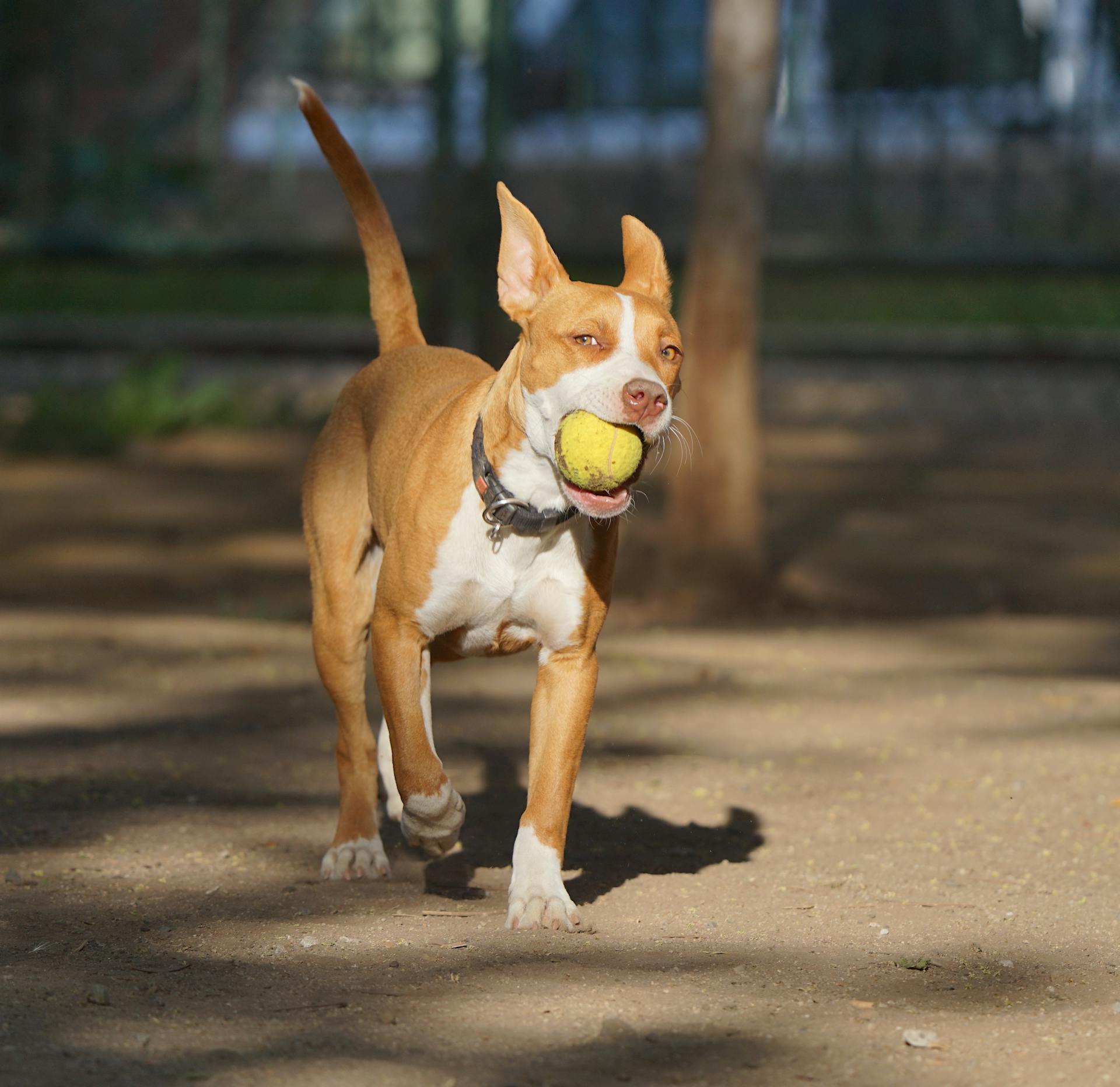
Here's a list of steps to take if you're the owner of the dog:
- Restrain your dog immediately
- Separate your dog from the scene of the bite
- Confine your dog in a safe place
- Check on the victim's condition
- Provide important information to the victim or others who are with them
- Call 911 if a response by paramedics is needed
- Obey local rules and laws regarding reporting of dog bites
- Consult with your veterinarian about dog behavior
What to Do If Bitten
If you're bitten by a dog, it's essential to take care of the wound right away. Clean the wound with mild soap and running water, then cover it with a clean bandage or cloth.
Some wounds require stitches, ideally within 12 to 24 hours. If you're bitten by an unknown or stray dog, go to the emergency room, as you might need medicines to prevent rabies (rabies post-exposure prophylaxis).
You should get the dog's owner's contact information and make sure the dog is vaccinated against rabies. This is crucial, as it will help you get the necessary treatment if you develop symptoms of rabies.
If the injury is serious, such as a bite on the face, heavy bleeding, or a possible broken bone, go to the emergency room immediately. Emergency rooms can be crowded, so an urgent care clinic is a good option if the injury doesn't require immediate attention.
If this caught your attention, see: States Require Doctors
The doctor may prescribe antibiotics to prevent possible infections, especially if you have health problems such as a weakened immune system or diabetes. You may also need a tetanus booster if you haven't had one in the past 10 years.
Monitoring the Wound:
- Check the bite often to see if it becomes red.
- Look for signs of swelling.
- Check if the wound is warm to the touch.
- See if the wound is tender to the touch.
If the wound gets worse, you feel pain, or develop a fever, see a doctor immediately.
Sources
- https://www.ipetskc.com/pet-safety/dog-bite-prevention-pet-safety/
- https://www.avma.org/resources-tools/pet-owners/dog-bite-prevention
- https://www.webmd.com/pets/dogs/dog-bites
- https://www.healthline.com/health/dog-bite-treatment
- https://www.health.harvard.edu/blog/dog-bites-how-to-prevent-or-treat-them-202404013029
Featured Images: pexels.com
